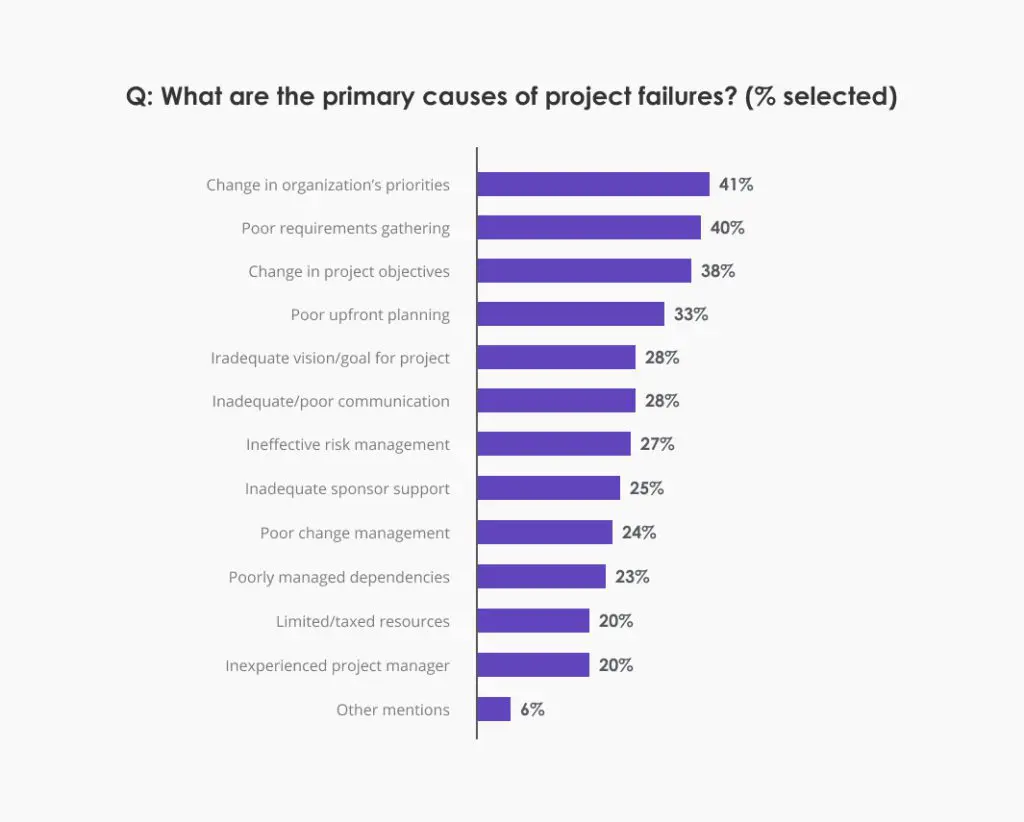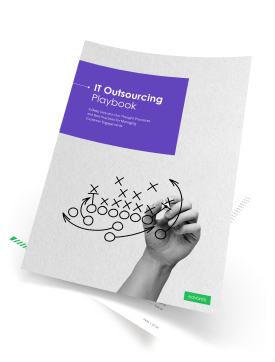Behind every successful product stands a clear vision — a sentiment your teams can refer to at every stage of the software development lifecycle. Outsourcing partnerships are no exception: a clear vision is the first vital step to moving your collaboration in the right direction.
The trick, however, is that when you are working with an outsourcing partner, you need to have a clear project vision at the early stages of the engagement. So how do you formalize it and then share it with a remote team? This guide provides a lowdown.
What is a Project Vision?
A project vision is a short statement or paragraph that summarizes the goal of the project and how it fits within your organization’s overall strategy. In short, it describes the difference your product will make when it hits the market.
Vision statement shows the “why” behind the project rather than specifying the precise plans on how you will achieve the set goals. This is a job for later phases.
Project vision is often confused with the mission statement and scope of the project. While these things are connected and rely on one another, they have completely different meanings for your business. Consider it this way: the mission statement describes where the organization is now, the vision — where it aims to be in the future, and the project scope — what needs to be done to get there.
To develop a project vision you will typically ask yourself:
- Why do we initiate product development?
- What problem are we hoping to solve?
- Is the product valuable and relevant for the target audiences?
- What factors will define product success?
Having these questions answered is critical since the vision serves as a basis for other aspects of your project such as:
- Goal definition
- Requirements elicitation
- Project planning
- Creation of WBS
- Project management
- Choosing priorities
- Fostering team spirit
An integral part of the product development life cycle, project vision forms the foundation for forming goals, plans, and requirements. Ultimately, it is one of the most important factors in determining the success rates of a project.
As illustrated in the bar chart below, 28% of projects fail due to inadequate project vision. But the situation is more nuanced: priorities, requirements, objectives, and planning activities all depend directly on the vision statement. As a result, the top four reasons for project failure are also partly “vision-related”.

Source: PMI Pulse of the Profession 2021
The vision in project management can evolve as new data becomes available, market conditions change — that’s fine. But you should have at least some sort of general vision when you decide to develop a new software product. Or else you would be trying to run the engine with an empty gas tank.
How to Refine Your Project Vision for a Software Development Project
Ultimately, your business vision statement should be clear to your stakeholders, team members, and outsourcing partners. It will enable them to take consistent action, recognize the importance of every task, and make decisions in challenging and unexpected situations. But a sheer idea is not enough — you need to refine it. But how?
In most cases, the process of refining and brainstorming the idea looks like this:

From the initial concept to lots of brainstorming and revision, and finally to an adequate, condensed project middle — this is the journey most teams take to create an encapsulated project vision statement.
But how do you untangle the messy ideation web?
We’ve outlined a few recommendations to assist you in developing a refined vision statement.
1. Consider the End Goal of Your Project
Visions are mental often positive pictures of the future. So let’s mind-travel there. Imagine that you are about to launch your product to the market. How would it influence stakeholders? What difference would it make to your business and the market as a whole? What user needs would it cover?
Be optimistic when answering these questions and don’t worry about being too bold. Later on, you will break down the vision into more realistic, achievable goals, and then into project deliverables and tasks. Once that’s done, only work remains!
But first things first: WHY should this product exist?
2. Identify if There is a Potential Business Opportunity
An idea that has the potential “market nutrition” to grow is a business opportunity. Market conditions, user preferences, and competition all influence the success rates of your product. To determine if there is a chance for your business to grow, you should evaluate all the above.
Once more, ask yourself:
- What do you know about the market and what are your assumptions?
- How can users benefit from the solution?
- Do other products meet users’ needs well enough? How will you differentiate?
3. Generate a Problem Statement
A problem statement describes the user’s pain points and how your solution could resolve them. Put yourself in the shoes of your potential customers: identify the barriers they face and figure out what holds them back from overcoming them. Focus on these key points:
- What is the problem?
- How does it impact the users?
- What would be a perfect solution to a problem?
- How would your solution make things better?
4. Summarize the End-Users Needs
Think of it this way: by creating a product you give your users a roadmap to the treasure — promised product value. What would make this promise enticing enough to embark on the journey? Why should they look at the map in the first place?
Discover where the need for your solution arises by contemplating:
- Who are your user personas?
- What do they want/miss/need/care about?
- How can your product deliver on their wishes if it hits the market?
5. Think of an Approximate Product Structure and Features
Now that you are aware of your users’ needs, think about how you’d like your product to look and behave. Outline a basic overview of the potential complexity of the app, approximate components it should have, the feature list, etc.
There is no need to go into detail: it’s perfectly fine to keep the overview high-level, highlighting only the most important points. As you move to the later stages, you will only need to expand and refine your assumptions with the help of your team.
6. Crystallize a Unique Value Proposition
Customer-attracting products don’t simply solve a specific need. They deliver it faster, cheaper, or better than their competitors. For that to happen, you must develop an individual value proposition. It consists of statements about your product that set it apart from the competition.
Describe specific benefits your project offers, how it deals with your target customers’ pain points, and why they should go for it over the competition. You have something unique — just show it!
7. Form a Project Vision Statement
Now it’s time to gather all this info and mark the beginning of your vision statement. Don’t be intimidated — it doesn’t have to be a document that follows a particular structure.
The form is not important at this point. It is your vision’s content that matters. Write down all the above information and work out an underlying statement, connecting the dots. Are you trying to reach every household with your product? Want to entirely change the way something is done? Let your imagination float: the only requirements for your vision are the following:
- Accepted by all other stakeholders
- Designed with optimism in mind
- Easily understood by third parties
Speaking of the latter…
How to Communicate Your Project Vision to a Development Partner
Apart from knowing the technical details, your outsourcing partner needs to understand the broader context of your project. For example, with a clear vision in our hands, Edvantis can:
- Provide valuable second opinions based on our experience
- Adjust service model to client’s specific needs and according to operations they have in place
- Manage or co-manage teams more efficiently (in Fixed-price Project and Dedicated Team service models)
Refining your vision is the first step to making it work. Once that’s done, you have to communicate it clearly to your partner. Listed below are recommendations that worked for our clients.
1. Articulate Your Vision During Pre-Engagement Discovery Sessions
A pre-engagement meeting allows your outsourcing vendor to become more familiar with your project. It involves gathering preliminary information about your project and making the first assumptions about the potential product development strategy. And project vision is one of the things you have to be ready to talk about for your vendor to form the right picture.
Pre-engagement sessions are a semi-formal period when you exchange project details with your partner. It is during this time that you both can first and foremost determine if you are a good fit and will generate maximum value from our partnership.
If clients do not know what they want to build, the project will inevitably go awry, hired people will disengage. After all, no coherent vision = no successful project.
2. Consider Doing a Discovery
The discovery phase is a pre-development step that helps shape the preliminary roadmap for the forthcoming product development. To perform the discovery phase, we usually conduct product delivery workshops — a series of 2-6-hour meetings.
During these meetings, our goal is to help you formalize your software vision, refine the main problem statement, outline potential risks, and define the scope and boundaries of the proposed solution.
It’s at this point when your vision starts to shape your initial plans, requirements, and assumptions. It’s when your vision kicks into action!
3. Cultivate a Shared Project Vision With Your New Team
Shared vision describes how your team visualizes the finished product’s look, performance, and reception by the customers. The team’s ability to see the big picture, their motivation, and productivity depend on how well they understand your vision.
The same holds true for your outsourcing partnership. No matter whether you manage remote specialists yourself, co-manage a team with a vendor, or delegate management entirely to your outsourcing partner, you will need a clear vision in place.
A shared vision is a product of deliberate and regular communication, namely knowledge-sharing workshops, document sharing, regular meetings with a team, introductory meetings with new specialists.
Ensure that these communication practices are done regularly. Consequently, your new team will step on the same page with you, come up with fresh ideas, and be inspired!
Conclusion
Visioning is as important a step as the actual development. If you know what you want to do and, more importantly, why you want to do it, it will be easier for your partner to onboard and share your vision. So don’t treat the process of refining and shaping your vision as just some vague and unnecessary venture. If you want your project to have a future — envision it first!
Looking for an experienced technology partner to act as a sounding board for your vision? Get in touch with us!



